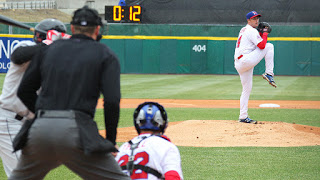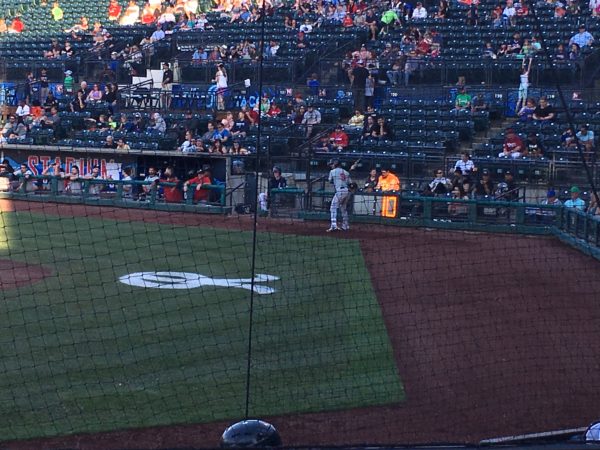Pitch Clocks Don’t Belong in Baseball


Clocks control our lives.
We wake up when the clock tells us to, we get to work on time, we watch the clock all day until we can go home and we do it all again the next day. Can’t we have just one nice thing without the clock constantly ticking our lives away?
Let me preface this by saying I am 26 years old, I was raised by the steroid era of the late 90’s and I am not some crusty old “get off my lawn” grandpa, but I am about to sound like one.
Clocks don’t belong in baseball. Almost every other sport you can think of involves a clock, but that’s what makes baseball unique and America’s pastime. The definition of pastime is “an activity that someone does regularly for enjoyment rather than work, for leisure, amusement.” Why does baseball have to have a clock? Will shaving five or ten minutes off of a game really bring in a measurable amount of new fans?
I am not saying the game pace should not be quickened but there are plenty of ways to do that without involving a clock. Clocks are for football, futbol, basketball and hockey.
Before you stop reading this and roll your eyes, let me tell you what I saw this past week in Tacoma when the El Paso Chihuahuas played the Rainiers in a Triple-A contest. I saw the clock take over a game and impact it the way I dreaded it would when the pitch clock was announced.
For the first time in the 30-plus minor league games I have watched over the last three seasons, I witnessed a pitch clock violation. Actually, I witnessed three. El Paso’s Luis Urias was awarded first base after Tacoma starter Roenis Elias was penalized for a pitch clock violation on a three-ball count, giving Urias ball four. Carlos Asuaje was awarded a ball a few innings later when Elias again pushed the pitch clock passed the limit, causing home plate umpire Clay Park to penalize Elias once again.
Tonight’s home plate umpire has called TWO pitch clock violations on Rainiers starter Roenis Elias, awarding El Paso two balls. The first two I’ve ever witnessed. Rainiers manager Pat Lisatch (#4) clearly a bit frustrated about it during Carlos Asuaje’s at bat. #Padres @EVT_News pic.twitter.com/8y0VurMi3p
— Nick Lee (@NickLee51) May 23, 2018
The third instance went against the Chihuahuas when they were up to bat as Allen Craig, on a two-strike count, was called out on a third strike for delay of game after not getting set in the box in time.
Give umpire Clay Park credit as he was consistent in his calls and his explanation seemed to appease both managers as no one was ejected or really even argued intensely, at least outwardly, with Park. He was just doing his job and I heard him tell Tacoma manager Pat Listach “he left me no choice” referring to Elias’ lack of urgency. He was citing the rule in place for the pitch clock in Minor League Baseball:
“Should the pitcher fail to begin his wind-up or begin the motion to come to the set position in 20 seconds, a ball will be awarded to the count on the batter.”
I am certainly open to other ideas to cut dead time in baseball. More appealing ideas would be limiting pitching changes during an inning, allowing 40-man rosters in April instead of September, limiting warm up pitches between innings, less commercial breaks and fixing the replay system. There, no clocks.
The year before pitch clocks, the average length of a game in the Pacific Coast League in 2014 was 2 hours and 58 minutes. In 2016, after two seasons of the pitch clock, it was down to 2 hours and 48 minutes. Are there really that many people lined up to watch baseball “if only it was 10 minutes shorter”?
Opinions have varied all over the chart about pitch clocks. Andrew Miller, the star reliever for the Cleveland Indians, in an article by MLB.com stated that he and many other players “Are not fans of the pitch clock…”
I asked Nick Schulz, El Paso’s outfielder, his opinion on the matter, “I’m honestly not the biggest fan.”
Baseball is about the kids. Kids will like baseball because it’s baseball not because they can leave the ballpark before 10pm after a 7:05pm first pitch. If someone likes baseball, they like baseball for what it is.
Rob Manfred is rightfully concerned about sustaining interest from the younger generation. Without using clocks, this can be done in several ways. Major League Baseball criminally under-utilizes their stars like Mike Trout, Francisco Lindor and Bryce Harper. Most good, young players these days have a pizzazz and flair not seen before. Why not advertise that? Take to social media, commercials, Saturday Night Live skits or heck, have a type of “Comic Con” during the offseason where players visit cities, kiss babies and sign autographs in groups, not just individually.
Also, fine and suspend pitchers more harshly who want to squash that enthusiasm by throwing at players who previously admired their handiwork or celebrated a big moment.
That’s how you engage the younger generation. You let the young guys be themselves and look, well, young. The Latin players are so fun to watch and part of that is the passion that they wear on their sleeves and the emotion they show. These are humans, not robots.
So many different things can enrich this great game we all love. If you are reading this, you likely already like or even love baseball. We are on the same side of wanting what’s best for our great game. Clocks are great for a lot of things but one of them is not governing the previously timeless game of baseball.
Native of Escondido, CA. Lived in San Diego area for 20 years. Padres fan since childhood (mid-90s). I have been writing since 2014. I currently live near Seattle, WA and am married to a Seattle sports girl. I wore #19 on my high school baseball team for Tony Gwynn. I am a stats and sports history nerd. I attended BYU on the Idaho campus. I also love Star Wars.